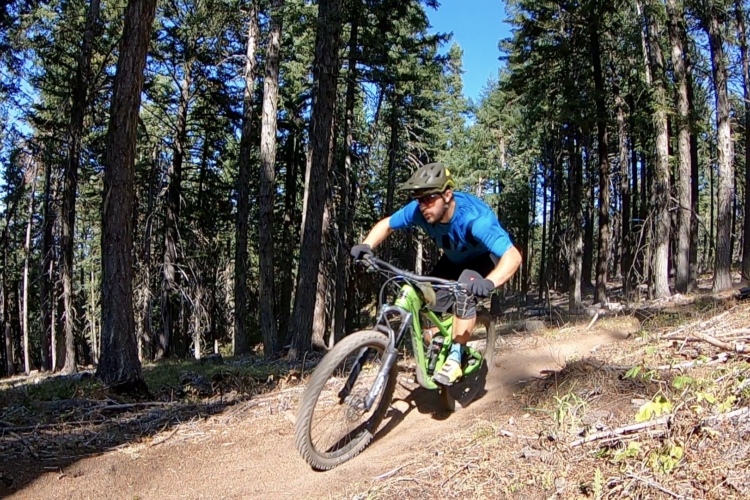The Specialized Camber saw big updates this year, and I got the chance to ride the top-drawer S-Works version at Outdoor Demo last week. Compared to the Camber I reviewed in 2011, there really is no comparison–this is pretty much an all-new bike.
The Bike
I should probably start this review off by stating the retail price of the bike I tested: nine thousand, eight hundred American dollars. Yep, this has to be the most expensive I’ve ever ridden, and it’s certainly not a bike that many riders can afford. The good news is that Specialized offers about a dozen different Camber configurations starting at $1,900. No matter which version of the Camber you choose, you’re getting the same geometry and basic suspension design, just with different bells and whistles.
The Camber is a 120mm travel (front and rear) trail bike that’s available as either a 29er or 27.5 bike (Specialized still calls the tweener size 650b). The S-Works version I tested features a full carbon, FACT 11m carbon fiber frame that’s designed to be as lightweight as possible without sacrificing strength and durability.
Within the frame’s downtube you’ll find the Specialized SWAT door (above) hidden beneath the water bottle holder, which allows you to stash all kinds of gear (even more so if you ride a large size frame like me). Geeks everywhere can rejoice, as all carbon Camber frames feature the SWAT door, all the way down to the $3,800 Comp version. The S-Works Camber I tested even has a nook under the rear shock for stashing a multi-tool (included) and a chain tool hidden underneath the stem cap. Inspector Gadget only wishes his bike was this handy.


Up front, the S-Works Camber 29 sports a RockShox RS-1 that’s been modified with Specialized’s Spike Valve technology. For those who aren’t familiar with the RS-1, this is a full carbon crown fork with an inverted design that weighs a scant 1666g for the 29er version.

In the rear, Specialized utilizes a custom Fox shock with position-sensitive Brain technology and autosag. Brain technology is designed to “[know] the difference between rider and terrain inputs,” and on the Camber, the technology has been tuned to basically ignore the first 25% of the shock’s sag for improved trail riding performance. Autosag, as the name implies, makes it easy to set sag consistently, correctly, and automatically for each individual rider.
Beyond the frame and suspension, everything else on the S-Works Camber 29 is top-of-the-line: XTR hydraulic disc brakes, SRAM XX1 drivetrain, Specialized Command dropper seat post, 30mm internal-width Roval Traverse rims, carbon bars, and tubeless Specialized Ground Control tires. I don’t know exactly how much the build I tested weighs… but it ain’t much, especially for a 120mm trail bike.
On the Trail
I bet I know what some of you are thinking: For $9,800, this bike better do the pedaling for me and give me a massage after the ride! Unfortunately the latter will never come true, but as far as the pedaling goes, the S-Works Camber is such an efficient climber there’s a good chance you’ll be accused of hiding a battery in your downtube. As far as trail bikes go, I think it’s safe to say there probably isn’t another bike that climbs as well as the S-Works Camber 29.
On the trail and in the climbs, the Camber felt lightweight (it is) and as stiff as a board. There was zero noticeable bob and it felt as if every bit of power was being transferred directly from my muscles to the trail. Because the bike is so lightweight, I found myself shifting my weight back a little more than usual, in order to maintain rear wheel traction, just to make it up through the loose stuff.
To test the Camber’s descending prowess, I decided to take the bike on one of the rockiest trails on the Outdoor Demo test loop. I’ve been testing bikes on this particular trail for at least 5 years now, which is really helpful for comparing bikes year-to-year. The top of the trail is steep with big, chunky rocks and the Camber absolutely slayed the course with almost zero bounce. Unlike any bike I’ve ridden before (other than perhaps another Specialized like the Epic or 2011 Camber), this bike tracked the terrain like a SCUD missile, glued to every pebble and fissure along the way.
Mountain bike racers know that time spent in the air is time wasted, so by tracking the trail as closely as possible, the S-Works Camber 29 makes up tons of time on the descents. Note, however, that downhill speed does not always equal comfort. If you enjoy lofting off lips and bouncing over rocks with a nice cushion underneath, this may not be the bike for you. The ride quality offered by the S-Works Camber 29 is decidedly “race,” which stays true to the heritage and brand positioning Specialized has built over the past few decades.
My one gripe with the S-Works Camber (and many other bikes I tested, for that matter) is the lack of a second water bottle mount. Clearly there is plenty of room for one on this bike (especially on the size-large frame) and these days many riders like myself are trying to get away from carrying heavy hydration packs–especially when racing. One solution offered by the Specialized rep I spoke with is the Specialized bib shorts, which features a SWAT pouch for storing a bottle on the rider’s back, but this sorta misses the point of getting weight off the back and onto the bike.
Bottom Line
The Specialized S-Works Camber 29 is a race bike through and through, and the technology crammed into this rig is pretty incredible. While this particular build may be out of reach for many riders, it’s definitely cool to see much of this tech available down through the Camber line of trail bikes.
























1 Comments
Sep 25, 2015